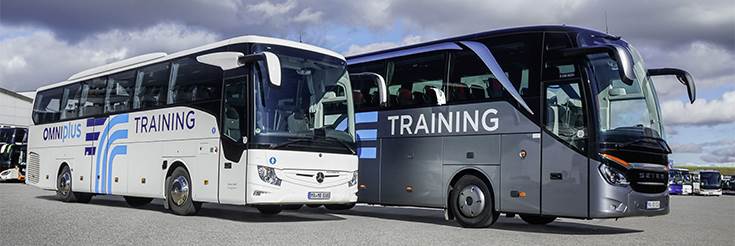We took a first look at the EV9 in a studio in Seongdong-gu, which Kia bosses described to us as the Seoul equivalent of Shoreditch – and if that doesn’t tell you all you need to know about the brand’s outlook, go and have a pint at the Truman Brewery on Brick Lane on a… Continue reading Can the Kia EV9 be a flagship offering to target young buyers?
Category: US Motoring Press
New Kia EV9 is seven-seat electric SUV with 337-mile range
The headlights and brakelights play an important design role, too, being oriented vertically and mounted right on the corners of the body to make the EV9 appear as wide as possible. Habib gave some hints as to how Kia will look to imbue future mass-market models with similarly distinct characters while retaining popular appeal: “We… Continue reading New Kia EV9 is seven-seat electric SUV with 337-mile range
Daimler Buses trains 20,000 drivers over 30 years
Daimler Buses has announced that it has trained almost 20,000 drivers since Daimler-Benz AG held the first Germany-wide safety training course for bus drivers in March 1993. The driver is key to keeping any bus/touring coach journey safe. An essential component of Daimler Buses’ integral safety concept is, therefore, the driver safety training of the… Continue reading Daimler Buses trains 20,000 drivers over 30 years
Okinawa clocks 250,000 sales, plans network expansion and electric cruiser bike
Okinawa Autotech, one of India’s leading electric two-wheeler manufacturers, has announced that it has clocked cumulative sales of 250,000 units in India. The company rolled out the 250,000th unit – a Praise Pro electric scooter – from its plant in Alwar, Rajasthan on March 14. The company, which began operations in 2015 at its 180,000… Continue reading Okinawa clocks 250,000 sales, plans network expansion and electric cruiser bike
Okinawa clocks 250,000 sales, plans network expansion and electric cruiser bike
Okinawa Autotech, one of India’s leading electric two-wheeler manufacturers, has announced that it has clocked cumulative sales of 250,000 units in India. The company rolled out the 250,000th unit – a Praise Pro electric scooter – from its plant in Alwar, Rajasthan on March 14. The company, which began operations in 2015 at its 180,000… Continue reading Okinawa clocks 250,000 sales, plans network expansion and electric cruiser bike
Global chief marketing officer at GM retires
Deborah Wahl, global marketing chief at General Motors, has elected to retire effective March 31. “We appreciate Deborah’s contributions since joining GM in 2018 and wish her well in her next chapter,” GM spokesman David Barnas said in a statement. “We will conduct an external search for a new Global Chief Marketing Officer.” The news… Continue reading Global chief marketing officer at GM retires
Ford’s Mustang Mach-E scores highest in crash safety test among 13 midsize SUVs
Ford’s all-electric 2021-23 Mustang Mach-E scored the highest in frontal crash safety testing against 13 midsize SUV competitors, according to the latest study released Tuesday by the Insurance Institute for Highway Safety (IIHS): The 2022-23 Tesla Model Y, 2022-23 Ford Explorer and the 2022-23 Subaru Ascent also earned good ratings for front crash protection for… Continue reading Ford’s Mustang Mach-E scores highest in crash safety test among 13 midsize SUVs
Fast facts on what it takes to test drive cars at GM
The testing performed at the General Motors Milford Proving Ground is grueling on both drivers and vehicles. The engineers who evaluate cars at high speeds are the top guns of driving and there are many safety measures in place. There’s also a strong support staff. The punishing testing of the vehicles leads to safer cars… Continue reading Fast facts on what it takes to test drive cars at GM
Volkswagen Will Invest $193 Billion in Electric Cars and Software
Volkswagen said on Tuesday that it would spend $193 billion on software, battery factories and other investments as it aimed to make every fifth vehicle it sold electric by 2025. The automaker, the world’s second biggest after Toyota, will also focus on expanding its presence in North America, where it has struggled for years, and… Continue reading Volkswagen Will Invest $193 Billion in Electric Cars and Software
Volkswagen announces five-year $193 billion investment plan as electrification gathers pace
People look at the Volkswagen id buzz electric car during the press day at the Los Angeles Auto Show in Los Angeles, California, November 17, 2022. Mike Blake | Reuters Volkswagen on Tuesday announced plans to invest 180 billion euros ($192.6 billion) between 2023 and 2027, with more than two thirds targeting “electrification and digitalization.”… Continue reading Volkswagen announces five-year $193 billion investment plan as electrification gathers pace


